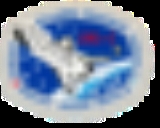
STS-45
Encyclopedia
STS-45 was a 1992 spaceflight using Space Shuttle Atlantis
.
's aft compartment during tanking operations. During troubleshooting, the leaks could not be reproduced, leading engineers to believe that they were the result of plumbing in the main propulsion system not thermally conditioned to the supercold propellants. Launch was rescheduled for 24 March. Launch weight: 105982 kilograms (233,650.3 lb).
Carried first Atmospheric Laboratory for Applications and Science (ATLAS-1) on Spacelab
pallets mounted in orbiter's cargo bay. The non-deployable payload, equipped with 12 instruments from the United States, France, Germany, Belgium, Switzerland, The Netherlands and Japan, conducted studies in atmospheric chemistry, solar radiation, space plasma physics and ultraviolet astronomy. ATLAS-1 instruments were: Atmospheric Trace Molecule Spectroscopy (ATMOS); Grille Spectrometer; Millimeter Wave Atmospheric Sounder (MAS); Imaging Spectrometric Observatory (ISO); Atmospheric Lyman-Alpha Emissions (ALAE); Atmospheric Emissions Photometric Imager (AEPI); Space Experiments with Particle Accelerators (SEPAC); Active Cavity Radiometer (ACR); Measurement of Solar Constant (SOLCON); Solar Spectrum (SOLSPEC); Solar Ultraviolet Spectral Irradiance Monitor (SUSIM); and Far Ultraviolet Space Telescope (FAUST). Other payloads included Shuttle Solar Backscatter Ultraviolet (SSBUV) experiment, one Get Away Special (GAS) experiment and six mid-deck experiments.
Landing: 2 April 1992, 6:23 am EST, Runway 33, Kennedy Space Center
. Rollout distance 2812 metres (9,225.7 ft). Mission extended one day to continue science experiments. Landing Weight: 93005 kilograms (205,040.9 lb).
Space Shuttle Atlantis
The Space Shuttle Atlantis is a retired Space Shuttle orbiter in the Space Shuttle fleet belonging to the National Aeronautics and Space Administration , the spaceflight and space exploration agency of the United States...
.
Crew
Mission parameters
- MassMassMass can be defined as a quantitive measure of the resistance an object has to change in its velocity.In physics, mass commonly refers to any of the following three properties of matter, which have been shown experimentally to be equivalent:...
:- Orbiter landing with payload: 93009 kilograms (205,049.7 lb)
- Payload: 9947 kilograms (21,929.4 lb)
- PerigeePerigeePerigee is the point at which an object makes its closest approach to the Earth.. Often the term is used in a broader sense to define the point in an orbit where the orbiting body is closest to the body it orbits. The opposite is the apogee, the farthest or highest point.The Greek prefix "peri"...
: 282 kilometres (175.2 mi) - Apogee: 294 kilometres (182.7 mi)
- InclinationInclinationInclination in general is the angle between a reference plane and another plane or axis of direction.-Orbits:The inclination is one of the six orbital parameters describing the shape and orientation of a celestial orbit...
: 57.0° - PeriodOrbital periodThe orbital period is the time taken for a given object to make one complete orbit about another object.When mentioned without further qualification in astronomy this refers to the sidereal period of an astronomical object, which is calculated with respect to the stars.There are several kinds of...
: 90.3 min
Mission highlights
Launch: 24 March 1992, 8:13 am EST. Launch originally scheduled for 23 March, but was delayed one day because of higher-than-allowable concentrations of liquid hydrogen and liquid oxygen in the orbiterOrbiter
An orbiter is a space probe that orbits a planet.-Asteroids:*NEAR Shoemaker...
's aft compartment during tanking operations. During troubleshooting, the leaks could not be reproduced, leading engineers to believe that they were the result of plumbing in the main propulsion system not thermally conditioned to the supercold propellants. Launch was rescheduled for 24 March. Launch weight: 105982 kilograms (233,650.3 lb).
Carried first Atmospheric Laboratory for Applications and Science (ATLAS-1) on Spacelab
Spacelab
Spacelab was a reusable laboratory used on certain spaceflights flown by the Space Shuttle. The laboratory consisted of multiple components, including a pressurized module, an unpressurized carrier and other related hardware housed in the Shuttle's cargo bay...
pallets mounted in orbiter's cargo bay. The non-deployable payload, equipped with 12 instruments from the United States, France, Germany, Belgium, Switzerland, The Netherlands and Japan, conducted studies in atmospheric chemistry, solar radiation, space plasma physics and ultraviolet astronomy. ATLAS-1 instruments were: Atmospheric Trace Molecule Spectroscopy (ATMOS); Grille Spectrometer; Millimeter Wave Atmospheric Sounder (MAS); Imaging Spectrometric Observatory (ISO); Atmospheric Lyman-Alpha Emissions (ALAE); Atmospheric Emissions Photometric Imager (AEPI); Space Experiments with Particle Accelerators (SEPAC); Active Cavity Radiometer (ACR); Measurement of Solar Constant (SOLCON); Solar Spectrum (SOLSPEC); Solar Ultraviolet Spectral Irradiance Monitor (SUSIM); and Far Ultraviolet Space Telescope (FAUST). Other payloads included Shuttle Solar Backscatter Ultraviolet (SSBUV) experiment, one Get Away Special (GAS) experiment and six mid-deck experiments.
Landing: 2 April 1992, 6:23 am EST, Runway 33, Kennedy Space Center
Kennedy Space Center
The John F. Kennedy Space Center is the NASA installation that has been the launch site for every United States human space flight since 1968. Although such flights are currently on hiatus, KSC continues to manage and operate unmanned rocket launch facilities for America's civilian space program...
. Rollout distance 2812 metres (9,225.7 ft). Mission extended one day to continue science experiments. Landing Weight: 93005 kilograms (205,040.9 lb).
See also
- Space scienceSpace scienceThe term space science may mean:* The study of issues specifically related to space travel and space exploration, including space medicine.* Science performed in outer space ....
- Space shuttleSpace ShuttleThe Space Shuttle was a manned orbital rocket and spacecraft system operated by NASA on 135 missions from 1981 to 2011. The system combined rocket launch, orbital spacecraft, and re-entry spaceplane with modular add-ons...
- List of space shuttle missions
- List of human spaceflights chronologically
- Nikon NASA F4Nikon NASA F4The Nikon NASA F4 Electronic Still Camera was one of the first and rarest fully digital cameras ever. Constructed for NASA, it was first flown in September 1991 on board the Space Shuttle Discovery, mission STS-48...

